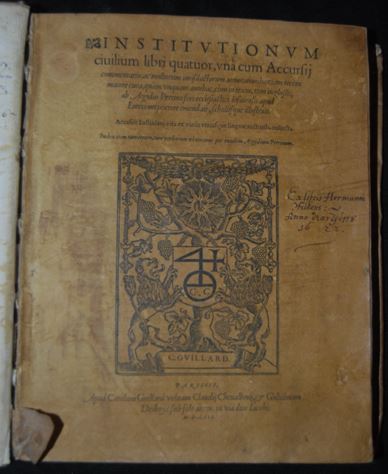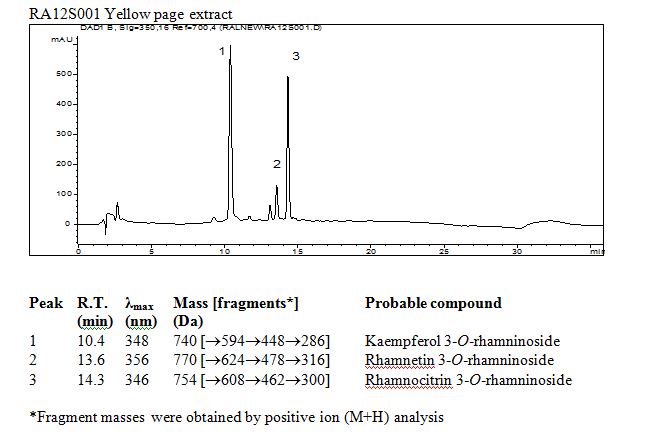Difference between revisions of "LGLL Rare26 17-0100, printed book (French, 1553)"
| Line 9: | Line 9: | ||
The book is unusual in that all of the text pages (about 440 pages; or 220 individual leaves) are a yellow-brown color. This, and marks throughout the book where water (or some liquid) was spilled on the pages, suggests that the pages were colored by a water-soluble dye of some sort, probably when the pages were unbound, because the color is very uniform. The end-pages were uncolored. | The book is unusual in that all of the text pages (about 440 pages; or 220 individual leaves) are a yellow-brown color. This, and marks throughout the book where water (or some liquid) was spilled on the pages, suggests that the pages were colored by a water-soluble dye of some sort, probably when the pages were unbound, because the color is very uniform. The end-pages were uncolored. | ||
| − | [[File:Yalebook 1.JPG|center|frame|Lillian Goldman Law Library, Yale University, Rare26 17-0100, Photo by | + | [[File:Yalebook 1.JPG|center|frame|Lillian Goldman Law Library, Yale University, Rare26 17-0100, Photo by by William S. Cotter (of W.S. Cotter, Rare Books) ]] |
| − | [[File:Yale book 2.JPG|center|frame|Lillian Goldman Law Library, Yale University, Rare26 17-0100, Photo by | + | [[File:Yale book 2.JPG|center|frame|Lillian Goldman Law Library, Yale University, Rare26 17-0100, Photo by by William S. Cotter (of W.S. Cotter, Rare Books) ]] |
== Summary of results == | == Summary of results == | ||
Revision as of 11:51, 11 December 2017
Information
Rare book in Lillian Goldman Law Library, Yale University, Rare26 17-0100.
Book title: “INSTITUTIONUM Ciuilium libri quatuor, una cum Accursij”.
This book was printed in Paris in 1553 by C. Cuillard. Apparently, it was rebound sometime after that as can be deduced by irregularities in the page margins, particularly at the tops of pages.
The book is unusual in that all of the text pages (about 440 pages; or 220 individual leaves) are a yellow-brown color. This, and marks throughout the book where water (or some liquid) was spilled on the pages, suggests that the pages were colored by a water-soluble dye of some sort, probably when the pages were unbound, because the color is very uniform. The end-pages were uncolored.
Summary of results
A sample of the colorant was extracted from the watermark at the bottom of column 210. A piece of Whatman 3MM filter paper (3 mm x 20 mm) was affixed to the back of the watermark (on column 211) with a paper clip. About 15 microliters of water was applied to one edge of the water mark and was allowed to soak through onto the filter paper. After the filter paper had dried, the darker parts of it (containing most of the extract) were extracted with about 150 microliters of methanol-water (1:1).
Twenty microliters of the above extract was analyzed on a High Performance Liquid Chromatography system having diode array and mass detectors (HPLC-DAD-MSD), with detection in the positive ion mode, which allows for detection of positively charged fragments of the dye molecules.
HPLC profile
Results and Discussion
The results are quite clear: the pages were colored using an extract of a species of the buckthorn (Rhamnus sp.) plant. The immature berries of this plant ("Persian berries" –also called “Avignon, Turkish, Greek, Hungarian, etc. berries”) were used in Europe for centuries to dye textiles yellow [1]. The signature for this dye is the presence of three main components, namely the three flavonol aglycones, kaempferol, rhamnocitrin and rhamnetin, each of which is linked to the trisaccharide (sugar), rhamninose (upper profile) [2]. When the dye mixture is treated with acid (e.g., hydrochloric acid), the sugars are cleaved off leaving just the aglycones (lower profile). The species of Rhamnus used remains unknown, however.
Normally the dye from Persian berries gives a bright yellow color. The pages of the book are a brownish-yellow color, which could have arisen from aging of other components in the extract. Another thing to consider is that flavonoids themselves are only a pale yellow color. To get a bright yellow, as when dyeing textiles, it is necessary to add a mordant, usually an aluminum salt, which forms a bright yellow complex (see below).
It is not known at this point why the paper was dyed. It could have been for aesthetic or possibly practical reasons. In a Chinese government decree of 671 AD it was stated that official documents should be written on yellow paper, i.e., paper dyed with extracts of the cork tree (e.g., Phellodendron amurense), as the yellow protoberberines comprising this dye were known to repel insects [3]. The dyes in Rhamnus species probably are not toxic, but other components of the extract are, as suggested by the name one of the species, Rhamnus cathartica [see https://en.wikipedia.org/wiki/Rhamnus_cathartica#Toxicity].
References
[1] Hofenk de Graaff, J.H. (2004), The Colourful Past, Archetype & Abegg-Stiftung, London, pp. 194-201.
[2] Cuoco, G., Mathe, C. and Viellescazes, C. (2014), “Liquid chromatographic analysis of flavonol compounds in green fruits of three Rhamnus spcies used in Stil de grain,” Microchemical Journal, 115, 130-137.
[3] Tsien, T.-H. (1985), Science and Civilization in China, Vol. 5, Part I, ed. J. Needham, Cambridge University Press, Cambridge 74–76.



